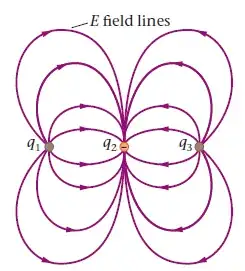This question is related for students of an high school. The that force lines can be used to represent an electric field. Lines of force have three fundamental properties:
1. Lines of force always emerge from a positive electric charge;
2. The resulting electric field is always tangent to the line of force at every point;
3. The intensity of the electric field is directly proportional to the number of lines of force passing through the unit area.
In relation to point 3., is there a physical relationship, without using Gauss's law, where the lines entering or leaving a charge is proportional to the magnitude of the charge? There are such problems in a school textbook without introduce Gauss's law.
Example: I have this image
Let us assume that the central charge $q_2$ is $10$ C. In this example the number of lines of force starting from $q_2$ is $16$. The lines of force coming out of $q_1$ and $q_3$ are half. So the charge on them must be $5$ C.
Addendum: I attach the screenshot of another Italian textbook in relation to point 3. without to introduce the electrostatic field flow. There is written Faraday's criterion ("criterio di Faraday"). >So is this Faraday criterion included only as a rule, or can it be proofed without the electrostatic field flow?
Related off-topics: Electric field lines properties and Flux received by a negative charge

